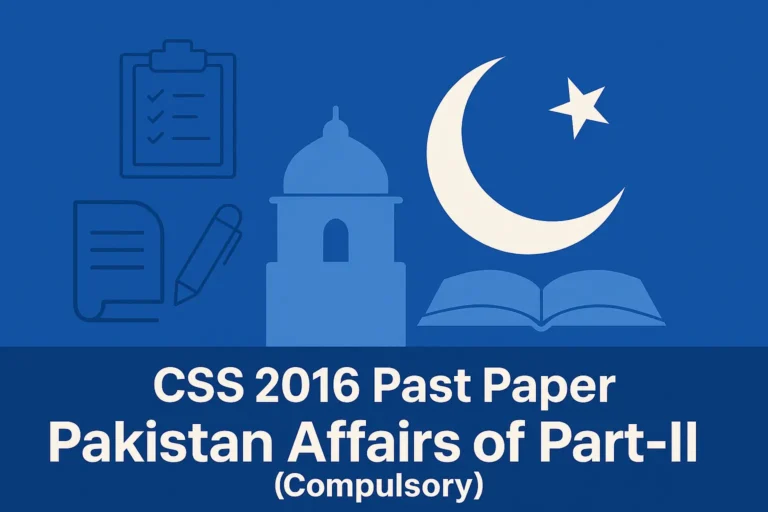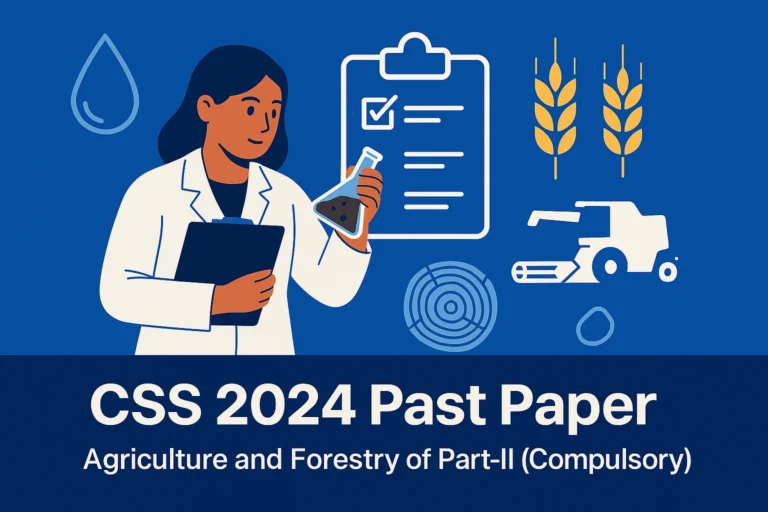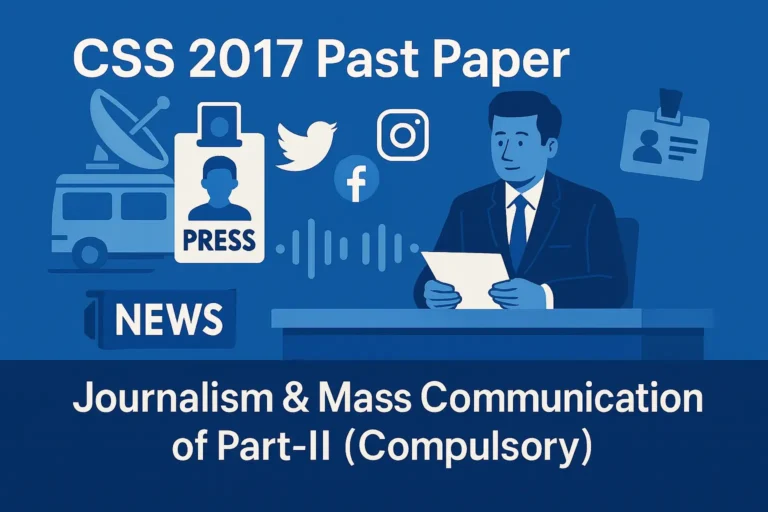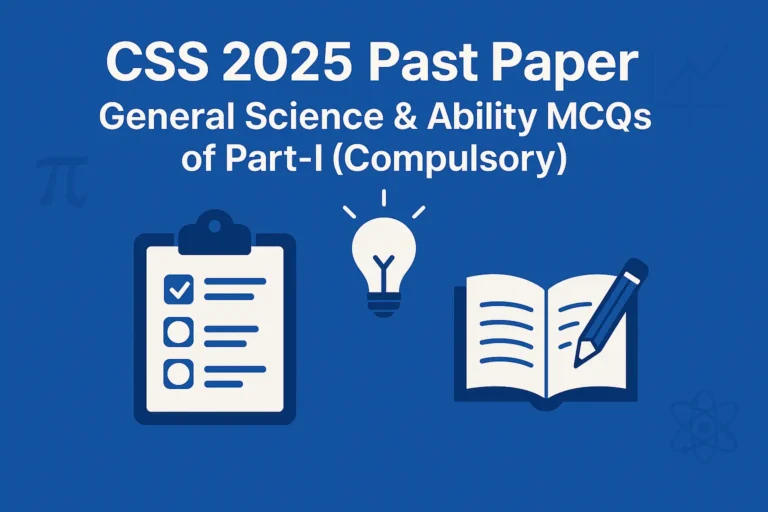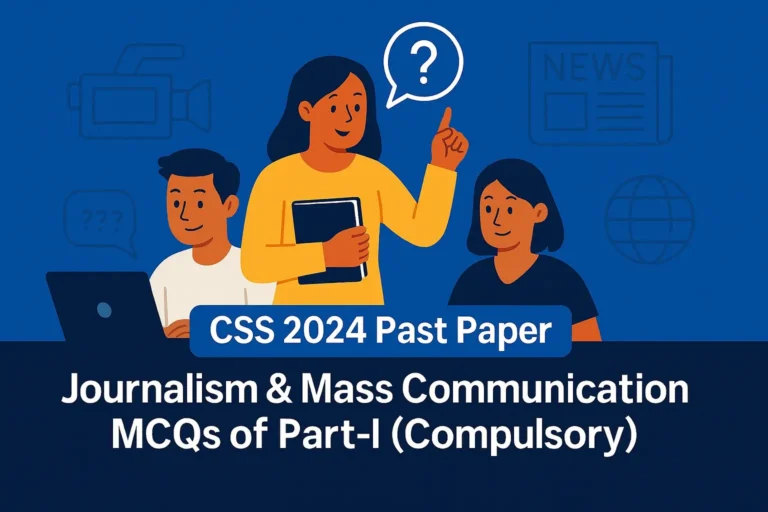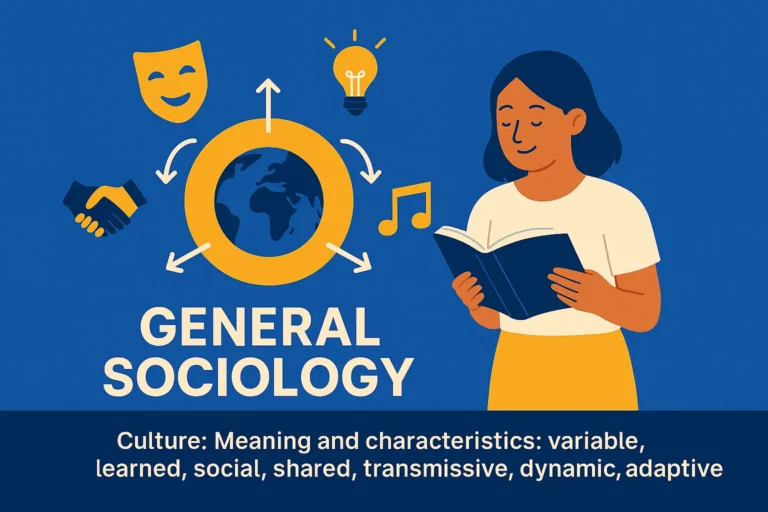CSS Past Paper 2024 Journalism and Mass Communication Descriptive (Part 2)
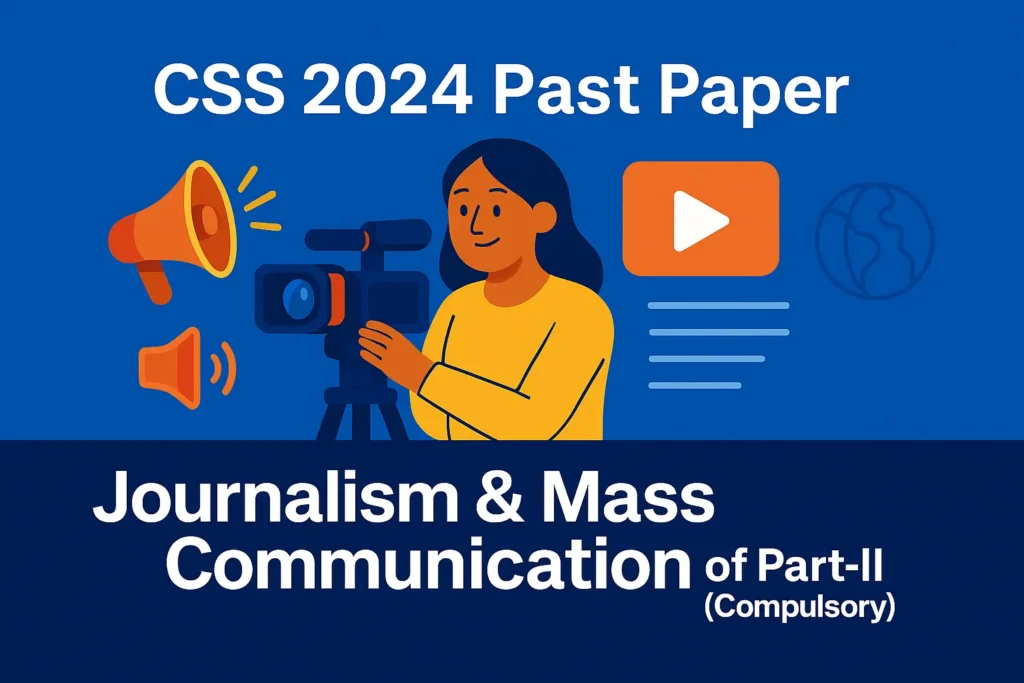
CSS | Past Paper | Group 7 | 2024 | Part 2 | Descriptive
Below is the solution to PART-II (COMPULSORY) of the CSS Past Paper 2024 Journalism and Mass Communication Descriptive (Part 2).
Question 2
To what extent does the Magic Bullet theory retain relevance in the context of the digital social age? Provide supporting examples to illustrate its applicability or limitations in today’s media landscape.
Introduction
Magic Bullet Theory, also known as the Hypodermic Needle Theory, was one of the first theories in mass communication. It believes that media messages are directly injected into the minds of a passive audience, and people react in the same way. This theory was more relevant in the early 20th century, especially during times like World War I and II when propaganda had strong effects. But now, in the digital age, things are different.
Explanation of the Magic Bullet Theory
The theory says that media is powerful and audiences are weak. Once a message is delivered, people accept it without questioning. It’s like the media “shoots” the message and the audience receives it like a “bullet”.
Key Points of the Theory
- Audience is passive
- Media has direct and immediate effect
- No individual differences or interpretation
Relevance in Digital Social Age
Today’s media is not like the past. It is now digital, interactive, and fast. Social media platforms like Facebook, Twitter, TikTok, YouTube, and Instagram allow people to comment, share, and react.
Still Relevant in Some Situations
- Fake News and Disinformation:
- During COVID-19, people quickly believed and shared fake cures and conspiracy theories.
- Example: WhatsApp messages about garlic curing coronavirus spread fast, and many believed it without fact-checking.
- Political Propaganda:
- In some countries, political parties use social media to spread messages, and people follow without checking sources.
- Example: In US elections, misinformation campaigns influenced many voters.
- Clickbait Culture:
- Headlines are designed to get attention. Many users only read headlines and believe them.
- This shows that some audiences still behave like the theory suggests.
Limitations in the Digital Age
- Active Audience:
- People now question things. They fact-check and research before believing.
- For example, many users use websites like Snopes or Google to verify information.
- Two-Way Communication:
- Unlike old media, digital media allows people to reply, comment, or criticize. This breaks the “one-way” model of Magic Bullet.
- Audience Diversity:
- People react differently depending on age, education, background, and beliefs. One message doesn’t affect everyone the same way.
- Algorithm Control:
- Social media platforms filter what people see. This is more related to the “Filter Bubble” concept, not Magic Bullet.
Examples Showing Limitations
- In Pakistan, political news is received differently by PTI, PML-N, and PPP supporters. The same message doesn’t convince all.
- During elections, some people support one party while others strongly oppose it, even after watching the same news.
Conclusion
Magic Bullet Theory is partly relevant in today’s digital world. In some cases like viral fake news or emotional propaganda, people still react quickly and blindly. But most of the time, the audience is smarter and more active now. They don’t just accept everything. So, while the theory helps explain some behaviors, it is not enough to understand the full media impact in the digital age.
Question 3
Assess the current state of Freedom of Expression in Pakistan, outlining the primary challenges it faces. Explore the potential societal impacts of these challenges on Pakistan’s future and propose measures to address these concerns.
Introduction
Freedom of expression is a basic human right. It means that people have the right to speak, write, and share opinions without fear. In Pakistan, this right is promised by Article 19 of the Constitution. But in reality, this freedom faces many limits. Media, journalists, and even normal citizens are often scared to speak openly. This is a serious issue that affects democracy and the future of the country.
Current State of Freedom of Expression in Pakistan
In recent years, the situation has become worse. Journalists are facing pressure, censorship, threats, and sometimes violence. Social media is also monitored. People who speak against the government, military, or powerful groups often get in trouble.
Examples
- Many news channels have been taken off air for showing critical content.
- Journalists like Hamid Mir, Asad Toor, and others have faced attacks and bans.
- On social media, users have been arrested for posting political opinions.
Primary Challenges to Freedom of Expression
- Censorship and Content Control:
- Media houses are told what to show and what not to.
- Certain topics like military issues or Balochistan are treated as “off-limits”.
- PEMRA Regulations:
- The media regulator, PEMRA, has issued strict rules.
- Sometimes, these rules are used to silence critical voices.
- Threats and Violence:
- Journalists are attacked or even killed.
- Fear of safety forces many reporters to self-censor.
- Cybercrime Laws (PECA Act):
- The Prevention of Electronic Crimes Act is often used to arrest or harass people online.
- Critics say it’s being misused.
- Political Pressure:
- Governments in power want media to support them.
- Opposition voices are often ignored or silenced.
Societal Impacts of These Challenges
- Weak Democracy:
- A free press is important for a strong democracy. Without it, the public cannot make informed decisions.
- Public Mistrust:
- When media is controlled, people lose trust in news and government.
- Brain Drain:
- Many journalists and intellectuals leave the country due to unsafe conditions.
- Rise of Fake News:
- When real news is hidden, people start believing rumors and false stories.
- Suppression of Youth Voice:
- Young people on social media feel scared to talk about politics or social issues.
Proposed Measures to Address the Issue
- Strengthen Legal Protection:
- Laws should protect journalists instead of punishing them.
- Reform of PECA Act:
- This law should be changed to stop misuse and protect digital freedom.
- Independent Media Bodies:
- PEMRA should work freely without government or military pressure.
- Promote Media Literacy:
- People should be taught how to identify real news and use media responsibly.
- Dialogue Between State and Media:
- Government, media, and civil society should work together to create a safe environment.
Conclusion
Freedom of expression is not just a right; it’s a need for any country to grow. Pakistan must take serious steps to protect this right. A free media helps expose corruption, protect human rights, and improve governance. Without it, Pakistan’s democracy and progress will always stay weak. The future of the country depends on the voice of its people being heard without fear.
Question 4
Critically examine the impact of cultural imperialism on contemporary communication practices globally. Discuss how dominant cultures influence the communication landscape and assess its effects on preserving cultural diversity and indigenous identities?
Introduction
Cultural imperialism means when a powerful country or culture dominates weaker ones by spreading its values, traditions, language, and media. In today’s world, communication is mostly controlled by a few rich and strong countries, especially Western nations like the USA. This has changed the way people all over the world think, talk, and live. It has many effects on media, languages, cultures, and identities.
Understanding Cultural Imperialism
The term became famous during the 20th century, especially during colonization. But now, instead of armies, it spreads through media, movies, music, fashion, and technology.
Examples
- Hollywood movies are watched globally while local cinema struggles.
- English has become the main language for global communication.
- Fast food chains like McDonald’s are found even in small towns worldwide.
Impact on Global Communication Practices
- Language Dominance:
- English dominates global media, journalism, and even education.
- Local languages get ignored or seen as “less important”.
- Media Ownership:
- Big companies like Disney, Netflix, CNN, and BBC set the tone for global news and entertainment.
- Most content is made to match Western lifestyles.
- Western Values in Media:
- Media promotes values like individualism, materialism, and consumerism.
- This changes traditional cultures that focused more on family or community.
- Social Media Algorithms:
- Platforms like Facebook, YouTube, and TikTok promote content based on popularity—not cultural importance.
- Western content gets more views and is copied more.
Influence of Dominant Cultures
- Fashion and Lifestyle:
- Youth in many countries copy Western fashion, food, and trends.
- Traditional clothing and customs are seen as “backward” or “old-fashioned”.
- News and Information Control:
- Global news focuses more on Western events.
- Stories from Africa, South Asia, or Latin America often get ignored.
- Advertising and Branding:
- Western brands are shown as symbols of success.
- Local brands struggle to compete.
Effects on Cultural Diversity & Indigenous Identities
- Loss of Identity:
- People forget their language, music, dress, and values.
- Indigenous tribes and small cultures are disappearing fast.
- Erosion of Local Traditions:
- Festivals, rituals, and customs are not followed by new generations.
- Cultural Confusion:
- Young people get stuck between their traditional values and modern lifestyles.
- Resentment and Resistance:
- Some communities push back against cultural imperialism.
- Examples include local cinema industries like Lollywood, Bollywood, and Korean wave (Hallyu) fighting back by promoting their own content.
Possible Solutions
- Promote Local Media:
- Governments and private sectors should invest in local content creation.
- Education and Awareness:
- Teach young people the value of their own culture.
- Support for Indigenous Languages:
- Translate content into local languages.
- Use native languages in schools and media.
- Cultural Exchange, Not Domination:
- Encourage equal cultural sharing between countries, not just one-way influence.
Conclusion
Cultural imperialism has deeply shaped global communication, making dominant cultures more visible and powerful. While it connects the world, it also puts local and indigenous cultures at risk. To protect cultural diversity, countries must support their own traditions, languages, and media. Communication should not destroy identity—it should celebrate and protect it.
Question 5
What is the significance of Public Relations departments for both Government and Private organizations? Provide examples.
Introduction
Public Relations (PR) is the way an organization builds and maintains its image and connection with the public. Whether it’s the government or a private company, PR plays a key role in communication. A strong PR department helps in building trust, handling crises, spreading messages, and shaping public opinion. In today’s fast-moving media world, PR has become more important than ever.
Definition of Public Relations
According to the Public Relations Society of America (PRSA), PR is “a strategic communication process that builds mutually beneficial relationships between organizations and their publics”.
In simple words, PR is how an organization manages its reputation by talking to people in the right way.
Importance of PR for Government Organizations
- Public Awareness Campaigns:
- Governments use PR to inform people about policies, laws, and public health.
- Example: During COVID-19, the Government of Pakistan ran awareness campaigns through TV, radio, and social media.
- Crisis Management:
- In emergencies like natural disasters or terrorist attacks, PR helps give clear, quick, and correct information.
- Example: NDMA (National Disaster Management Authority) uses PR to update citizens during floods or earthquakes.
- Building Trust with Citizens:
- Regular communication makes the public feel connected with the government.
- PR departments organize press conferences, issue press releases, and run social media pages.
- Policy Promotion:
- PR is used to highlight the positive work of the government, such as development projects or reforms.
- Example: Clean Green Pakistan campaign was promoted through PR channels.
Importance of PR for Private Organizations
- Brand Image and Reputation:
- PR helps companies build a good public image, which leads to customer trust.
- Example: Coca-Cola and Nestlé use PR to show their social responsibility and environmental efforts.
- Product Launches and Promotions:
- PR is used to create buzz for new products or services.
- Press events, influencer marketing, and media coverage are all managed by PR teams.
- Crisis and Damage Control:
- If a company faces backlash or failure, PR manages the situation to protect its reputation.
- Example: When Khaadi faced backlash for labor issues, their PR team issued statements to clarify their side.
- Internal Communication:
- PR also ensures that communication within the company (employees, shareholders) is smooth and positive.
- Corporate Social Responsibility (CSR):
- PR promotes the good work a company does for society.
- Example: Jazz Pakistan runs campaigns for digital literacy, which are promoted through PR.
Similarities in PR Role for Both Sectors
| Function | Government | Private Organization |
| Public Communication | Policy updates, campaigns | Product awareness, promotions |
| Crisis Management | Disasters, security issues | Scandals, product recalls |
| Image Building | National unity, development | Brand reputation |
| Media Handling | Press briefings, statements | Press releases, interviews |
Challenges Faced by PR Departments
- Misinformation and Fake News
- Social Media Backlash
- Fast News Cycle – Need for Quick Response
- Budget and Resource Limitations
Conclusion
PR is not just about advertising or promotion—it’s about building relationships, trust, and credibility. Both government and private sectors rely heavily on public relations to communicate effectively with the public. A strong PR department can shape public opinion, manage crises, and improve reputation. In the modern world where information spreads in seconds, PR has become a backbone of successful communication.
Question 6
Describe the importance of Development Support Communication in Pakistan’s progress. Discuss its methods, difficulties, and share examples.
Introduction
Development Support Communication (DSC) means using media and communication tools to support national development goals. It helps in spreading awareness, educating people, and changing behaviors in areas like health, education, agriculture, environment, and poverty. In a developing country like Pakistan, DSC plays a big role in solving problems and improving lives.
Importance of Development Support Communication in Pakistan
- Spreads Awareness:
- DSC informs people about important social issues like child marriage, health care, women’s rights, and education.
- Example: Polio campaigns in Pakistan used radio and TV to spread awareness.
- Promotes Behavior Change:
- Changing people’s habits is key for development. DSC helps in changing negative practices like open defecation, vaccine refusal, and school dropout.
- Example: “Zindagi Trust” campaigns promoted girl education through storytelling and media.
- Bridges Information Gap:
- Many people in rural areas don’t know about government schemes or benefits. DSC helps deliver this information.
- Example: Agriculture TV shows help farmers improve crop yield.
- Helps in Crisis and Disasters:
- During floods or earthquakes, DSC spreads alerts, safety tips, and rescue info.
- Community Mobilization:
- It motivates communities to take part in their own development.
- Example: “Clean Green Pakistan” campaign encouraged local participation in environment safety.
Methods of Development Support Communication
- Mass Media:
- TV, radio, newspapers spread messages to large audiences.
- Example: “Radio Pakistan” programs for rural education.
- Folk Media:
- Using local art like puppetry, street theatre, songs to spread messages in villages.
- Example: Theatre shows in Sindh about women’s health and hygiene.
- Interpersonal Communication:
- Health workers, teachers, and social workers interact directly with people to educate and convince them.
- Example: Lady Health Workers go door-to-door for family planning awareness.
- Social Media and Mobile Phones:
- In urban areas, WhatsApp, Facebook, and SMS alerts are used to spread info.
- Example: COVID-19 updates through government mobile alerts.
- Community Media:
- Local radio stations and cable channels spread messages in local languages.
Challenges Faced in Pakistan
- Low Literacy Rate:
- Many people can’t read or write, so written communication doesn’t work everywhere.
- Cultural Barriers:
- Some topics like family planning, gender rights are sensitive and hard to talk about openly.
- Poor Infrastructure:
- In remote areas, there is no internet, TV signals, or mobile coverage.
- Lack of Funding:
- Government often ignores DSC and doesn’t provide enough budget.
- Political Interference:
- Development messages are sometimes blocked or changed due to political reasons.
- Limited Media Reach:
- Most media channels focus on cities and ignore rural populations.
Examples from Pakistan
- Polio Eradication Campaigns:
- Used radio, TV, and door-to-door awareness to promote polio drops for children.
- Ehsaas Program:
- Advertised through media to help people understand how to register for financial aid.
- Education Campaigns:
- Punjab Government used cartoons and short ads to encourage school enrollment.
Conclusion
Development Support Communication is not just an option—it is a need for Pakistan. Without proper communication, even good government plans fail. To achieve real progress, especially in rural and poor areas, Pakistan must invest more in DSC. With better planning, training, and modern tools, DSC can change minds, improve lives, and build a better future.
Question 7
What ethical issues do media professionals face in the digital age? Offer solutions to maintain ethical standards in digital media age for media professionals.
Introduction
The digital age has changed the way media works. News spreads faster, everyone can be a content creator, and social media gives voice to all. But with these benefits, there are also new challenges—especially ethical ones. Media professionals now face more pressure to be fast rather than accurate, popular rather than honest. This creates serious problems for truth, privacy, and professionalism in journalism.
Main Ethical Issues in the Digital Age
- Spreading Fake News:
- Media often shares news without fact-checking just to break the story first.
- Example: False reports about celebrity deaths or political events go viral before verification.
- Clickbait and Sensationalism:
- Headlines are made dramatic to get more clicks, even if the news inside is not accurate.
- This creates fear, confusion, and distrust.
- Invasion of Privacy:
- Media sometimes shows personal details of victims or families without consent.
- Example: Publishing photos of accident victims on social media.
- Lack of Verification:
- Due to speed, many digital journalists skip the basic steps of confirming facts from two or more sources.
- Plagiarism:
- Copying content from others without credit is common online.
- Paid Content / Advertorials:
- Some media mix advertisements with news and don’t label them clearly, which misleads the audience.
- Bias and Political Pressure:
- Media outlets sometimes take sides due to political funding or fear, instead of staying neutral.
- Deepfakes and AI Content:
- Fake videos and AI-generated voices are now being used to spread lies, and many people can’t tell the difference.
Effects of These Ethical Issues
- Public Trust in Media Drops
- Damage to Reputation of Journalists
- Wrong Information Can Harm Lives
- People Get Confused and Divided
Solutions to Maintain Ethical Standards
- Follow Journalism Ethics Codes:
- Media organizations must strictly follow ethics like truth, accuracy, fairness, and independence.
- Pakistan Federal Union of Journalists (PFUJ) and PEMRA should monitor this.
- Strong Fact-Checking Units:
- Before publishing anything, media houses should have teams to verify news.
- Example: International outlets like BBC and Reuters have in-house fact-checkers.
- Train Journalists in Digital Ethics:
- Newsrooms should train media workers on digital rights, cyber laws, and ethical reporting.
- Label Sponsored Content Clearly:
- If a post or article is paid for, it should be marked as “sponsored” to avoid misleading the audience.
- Promote Media Literacy Among Public:
- Teach people how to recognize fake news, deepfakes, and biased reporting.
- Strengthen Cyber Laws (With Balance):
- The government should make sure cyber laws stop unethical content—but also protect freedom of expression.
- Protect Whistleblowers and Investigative Journalists:
- Journalists who report the truth, even against powerful people, should be protected from threats or harassment.
- Encourage Self-Regulation:
- Media houses should create their own internal policies and ombudspersons to deal with public complaints.
Conclusion
Media professionals carry a big responsibility in the digital age. They are not just reporters—they shape opinions, expose truth, and protect democracy. But without ethics, media becomes dangerous. That’s why it’s important to bring back honesty, accuracy, and responsibility in digital journalism. Only then can media truly serve the people and the country.
Question 8
Write notes on any TWO of the following:
a. Digital Divide and Access to Information
b. Fake News and Disinformation
c. Two step flow model
a. Digital Divide and Access to Information
Introduction
Digital divide means the gap between people who have access to digital technology (like internet, computers, smartphones) and those who do not. In Pakistan and many developing countries, this divide is a big problem because it limits people’s ability to learn, work, and stay informed.
Causes of Digital Divide
- Poverty:
- Many people can’t afford devices or internet.
- Urban vs Rural Areas:
- Cities have better internet and electricity than villages.
- Lack of Digital Literacy:
- People don’t know how to use modern technology properly.
- Gender Gap:
- In some areas, girls are not allowed to use phones or internet freely.
- Infrastructure Issues:
- Poor internet signals and load-shedding in remote regions.
Effects on Access to Information
- Unequal Opportunities in Education:
- Students in poor areas can’t attend online classes or use Google for studies.
- Job and Skill Gap:
- People without digital access can’t apply for online jobs or learn new skills.
- Political and Social Disconnection:
- They miss out on news, government updates, and social services.
Example in Pakistan
During COVID-19, students in Balochistan and Gilgit-Baltistan couldn’t attend online classes because of no internet. This shows how the digital divide blocks access to basic rights.
Solution
- Government must provide cheap internet in rural areas.
- Digital skills training centers should be opened.
- Subsidies for mobile phones and laptops for students.
Conclusion
The digital divide is not just a technology issue—it is a development issue. Without equal digital access, millions of Pakistanis will be left behind. To ensure equal information access, digital inclusion must be a national priority.
b. Fake News and Disinformation
Introduction
Fake news is false or misleading information presented as news. Disinformation is fake news that is spread intentionally to fool or mislead people. In the digital age, fake news spreads faster than real news, especially on social media.
Types of Fake News
- Clickbait Headlines:
- Shocking titles to attract clicks.
- Satire Without Labels:
- Jokes or fake stories that some people believe to be true.
- Misleading Photos/Videos:
- Old or edited media used to mislead people.
Reasons Why Fake News Spreads
- Speed of social media (Facebook, WhatsApp, TikTok).
- People share without checking.
- Political or religious groups use it to control opinions.
- Lack of media literacy in the public.
Impact on Society
- Creates Panic and Confusion:
- Example: False rumors about vaccine side effects during COVID-19.
- Destroys Trust:
- People stop believing real news or government.
- Harms Democracy:
- Fake political stories affect elections and public opinion.
- Promotes Hate Speech and Violence:
- Disinformation is used to spread hate between religions or ethnic groups.
Solutions
- Fact-checking Websites:
- Platforms like AFP Fact Check and Soch Fact Check in Pakistan should be promoted.
- Digital Media Education:
- Teach students and public how to identify fake news.
- Stricter Social Media Rules:
- Platforms should ban pages spreading lies.
- Responsible Journalism:
- Newsrooms must confirm info before publishing.
Conclusion
Fake news and disinformation are modern threats to truth and peace. If we don’t fight them through education, regulation, and ethics, our society will remain divided and misled.
c. Two-Step Flow Model
Introduction
The Two-Step Flow Model of communication, developed by Paul Lazarsfeld and Elihu Katz in the 1940s, emphasizes that media influence is not direct. Instead, media messages are first received by “opinion leaders”, who then pass them on to others. This theory suggests that people are influenced by others within their social networks, rather than by mass media directly.
Key Features of the Two-Step Flow Model
- Opinion Leaders:
These are individuals who are more exposed to media content and who influence others within their social circles. They act as intermediaries between the media and the general public. - Audience Influence:
While mass media still plays a role in shaping opinions, the model argues that the effect on the audience is indirect, as information is mediated through opinion leaders.
Application of the Model
- Social Media:
In today’s digital age, social media influencers serve as modern-day opinion leaders. Their followers often look to them for guidance on various topics, from fashion to politics, rather than directly engaging with traditional media. - Political Influence:
Political campaigns often rely on key figures or influencers to communicate their messages. Opinion leaders, such as political analysts or public figures, can amplify or reshape how political messages are received by the broader population.
Limitations of the Two-Step Flow Model
- Complex Social Networks:
With the rise of social media, the flow of information is more complex than a simple two-step process. Information often spreads through multiple steps involving various intermediaries, making the model less applicable in contemporary times. - Diversity of Opinion Leaders:
The assumption that opinion leaders are uniformly influential across all topics does not always hold true. Different individuals may serve as opinion leaders in various contexts, which complicates the model’s structure.
Conclusion
While the Two-Step Flow Model was revolutionary in its time, the digital age and the advent of social media have altered how information flows. Nonetheless, the concept of opinion leaders remains relevant, especially in understanding how social networks influence public opinion today.
📘 Benefits of Practicing This Descriptive Paper
- ✅ These CSS Past Paper 2024 Journalism and Mass Communication Descriptive questions are compiled from authentic FPSC CSS past papers, following the real written exam format.
- 💬 Attempting this CSS Past Paper 2024 Journalism and Mass Communication Descriptive helps students master structured writing and analytical skills for CSS exams.
- 🧾 Every question in this CSS Past Paper 2024 Journalism and Mass Communication Descriptive strictly follows the official CSS exam syllabus approved by FPSC.
- 📊 Students preparing for CSS 2024 can rely on this CSS Past Paper 2024 Journalism and Mass Communication Descriptive to practice time management and topic selection.
- 🔍 The solved CSS Past Paper 2024 Journalism and Mass Communication Descriptive contains concise explanations to improve conceptual understanding and writing clarity.
- 🎯 Regular revision of this CSS Past Paper 2024 Journalism and Mass Communication Descriptive builds confidence and strengthens your preparation for the CSS written paper.
- 🏆 This CSS Past Paper 2024 Journalism and Mass Communication Descriptive is essential for mastering exam techniques and achieving success in the FPSC CSS examination.
🏁 Final Note
Keep revising these CSS Past Paper 2024 Journalism and Mass Communication Descriptive to strengthen your grip on important concepts and improve accuracy in upcoming CSS exams. Regular practice with these CSS Past Paper 2024 Journalism and Mass Communication Descriptive will help you score higher and build full command over the CSS exam syllabus.
👉 Also read CSS Past Paper 2024 Journalism and Mass Communication (Part-I MCQs)
🔗 Check FPSC past papers directly from the official FPSC website.

